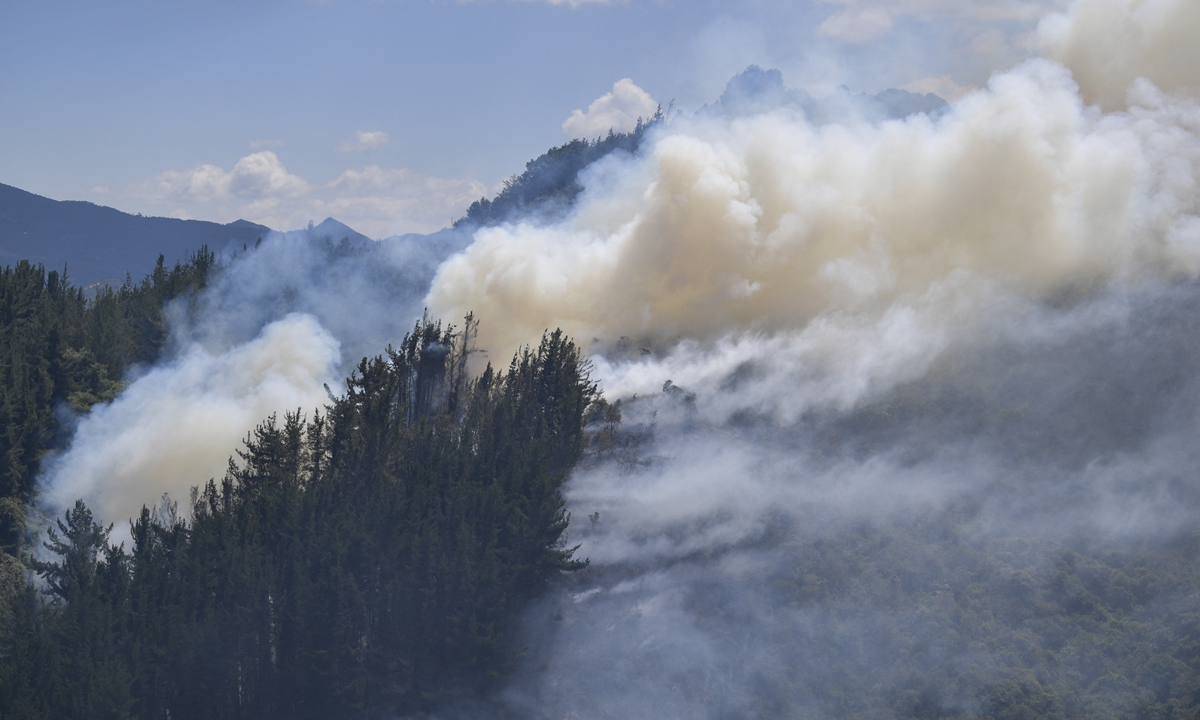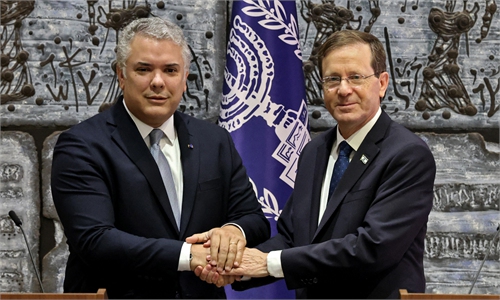
A view of the forest fire started after authorities found and burned a laboratory for cocaine process in Guasca, Colombia on February 13, 2020. Photos: AFP
Holding a mugshot poster reading "Most Wanted for Deforestation" and offering a $75,000 reward for information, Colombia's Defense Minister Diego Molano earlier in February blamed criminal groups for the country's worst forest fires in a decade.So far, six of the 17 suspects shown on the poster have been arrested and charged with committing environmental crimes after turning themselves in, according to the government.
Colombia has recorded more than 300 forest fires since mid-December that have razed at least 86,000 hectares, including the Amazon rainforest - double the forest loss recorded during 2021's fires.
The government blames the smoldering fires, concentrated in Colombia's central and southern provinces, on dissidents from the now-demobilized Revolutionary Armed Forces of Colombia (FARC), thousands of whose rebels have returned to arms after rejecting the 2016 peace deal signed with the government.
"The FARC dissidents create forest fires in the Colombian Amazon to grab land and develop extensive cattle ranching and coca crops," Molano told reporters in early February.
He said left-wing FARC dissidents involved in cocaine production had also burned trees to clear space for cattle ranching, to help them then launder drug trafficking profits.
Colombia is the world's top producer of cocaine, with some 200,000 hectares of coca plants, including in its national parks and protected forest areas.
The arrest of the suspected FARC dissidents follows passage of an environmental crimes law in August 2021. It carries prison sentences of up to 15 years as part of government efforts to stem deforestation by punishing those responsible.
Since the law came into effect, 84 people have been arrested for environmental crimes that include illegal logging and gold mining, and one person has been indicted for deforesting 84 hectares in the Amazon, according to the government.
'Big smoking indicator'
In Colombia's hard-hit southern Guaviare province, mostly man-made fires, fueled by hotter and drier conditions that cause them to burn over larger areas and at hotter temperatures, have destroyed about 15,000 hectares.
Huge fires that peaked in early February have since ebbed in Guaviare but have now flared up again in central Meta province in newly deforested areas, according to advocacy group Amazon Conservation.
"These are not random fires but are tightly linked to recent deforestation," said Matt Finer, a senior research specialist with the group.
"The fires are like a big smoking indicator of the current deforestation problem in Colombia," said Finer, who is also director of the Monitoring of the Andean Amazon Project (MAAP), which uses satellite imagery and its own monitoring app.
He said that "by far the main thing to be done to prevent future major fires" is to halt the general deforestation push in Colombia which "is driving the whole process."
According to Colombia's environment ministry, Colombia's Amazon in January had the most "hot spots" seen in a decade.
Those can represent both fires and climbing temperatures during Colombia's dry season, which typically lasts from December to February and is peak burning season as illegal loggers and forest-clearing crews take advantage of dry weather.
Fires have also destroyed swathes of forest in Colombia's Chiribiquete National Park - a sparsely populated wilderness home to indigenous reserves and prehistoric rock paintings.
Defense minister Molano said about 400 soldiers have been deployed to patrol the national park and try to catch the remaining suspects thought to have started the fires, as well as to destroy roads and bridges illegally built in the jungle.
The troops are part of the government's anti-deforestation initiative dubbed "Operation Artemisa," launched in 2019 to protect Colombia's national parks, step up operations against illegal armed groups and plant tens of millions of trees.
The preservation of the Amazon, the world's largest rainforest, is vital to curbing climate change because of the vast amount of carbon dioxide absorbed by its trees.
But across the Amazon, the battle to stem rising deforestation is being lost.
Despite government initiatives, deforestation in Colombia rose 8 percent to 171,685 hectares in 2020 compared to 2019.
Areas with the highest rates of deforestation are those also showing an increase in agriculture and cattle ranching.
In neighboring Brazil, recent government figures show similar trends.
The country, home to the largest share of the Amazon, recorded the highest-ever deforestation for January, with 430 square kilometers of rainforest lost, five times what was lost in January 2021.
High global prices for beef, soy and other commodities often produced on cleared forest land are one driver of the losses, analysts said.
Prevention needed
While the Colombian government blames the latest forest fires on FARC dissidents, other illegal armed groups and other contributing factors also are driving fires, experts said.
In February, 230 local and foreign environmentalists, lawyers and academics signed an open letter to Colombia's President Ivan Duque saying measures to deal with forest fires must be "preventative and not reactive."
The fires, worsened by 40 days without rain, have so far lacked a "timely and effective state response," they wrote.
They said it was also "unacceptable" that volunteer firefighters in protected areas lacked adequate equipment to douse flames.
Angela Maldonado, head of Entropika Foundation, an Amazon rainforest conservation nonprofit based in Colombia's Amazonian city of Leticia, said right-wing criminal gangs were behind much of the clearing of forest.
With little or no state presence in remote forest areas, criminal gangs and those involved in palm oil and coca production and cattle ranching are in "complete control," she said.
"The biggest problem Colombia has in protecting its biodiversity and to prevent deforestation is corruption," said Maldonado, a scientist and one of the signatories of the letter.
Political graft means permits are awarded to build roads in protected areas, a blind eye is turned to unauthorized clearing of land for cattle rearing, and state development and forest protection funds are misspent or don't reach affected areas, she said.
'No man's land'
Manuel Rodriguez Becerra, a former Colombian environment minister, noted that both the previous and current governments made "big commitments" to stem deforestation, including a pledge by the Duque government to reach zero deforestation by 2030.
But forest losses in Colombia, and across the Amazon basin, continue to rise, Rodriguez said.
Behind deforestation is a "complex mixture" of groups that include illegal gold miners, politicians and FARC dissidents, he said.
Consecutive governments have shown "very good intentions" but they have not been able to deliver on their pledges, in part because government presence is weak in remote areas, especially in former FARC guerrilla strongholds concentrated in the country's south and rural border areas, he added.
"Those particular regions are in a sense no man's land," said Rodriguez, a professor at Bogota's Los Andes University.
The peace deal that led to the FARC's demobilization has seen once no-go conflict areas in remote swathes of rainforest open up for business and draw growing interest from criminal gangs, who have pushed deeper into tropical forests.
To stem fires and forest losses, a "permanent presence" of the state is needed in such areas, he said, allowing the military to deal with fires and deforestation on the spot.
"Without that necessary condition, I am very skeptical," he said of government efforts to stem deforestation.
Changing the situation would require billions of dollars in investment, he said, in everything from helicopters to forest monitors as well as judicial, health and education services.
But "that money doesn't exist. ... After this pandemic the deficit is enormous," he said.
Reuters



